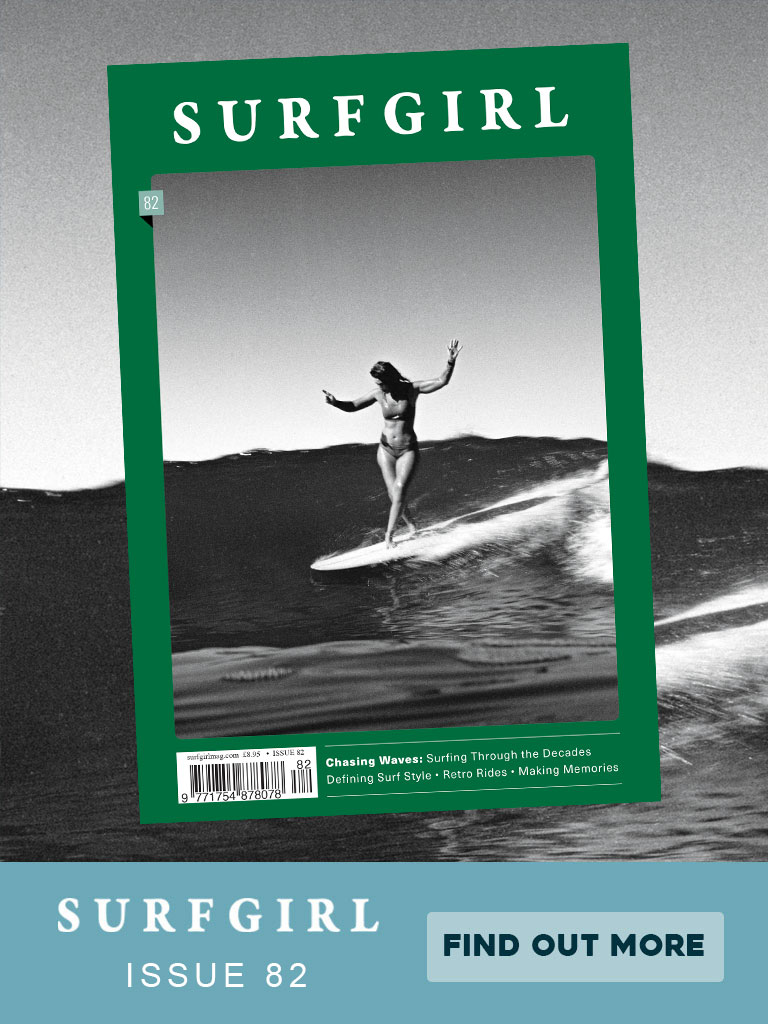
Over the past few months it’s been unusual to click on a news site without seeing an article involving women, filmmaking and allegations ranging from casual discrimination to out-and-out abuse. There’s been plenty of soul searching in Hollywood as a result, and it remains a burning topic in the run up to this year’s Academy Awards – cinema’s biggest night of the year.
Whether you’re in the movie business or in the audience, it leaves you scratching your head and wondering, “What are we going to do?” One obvious answer is getting more women in the director’s chair, behind the camera, in production roles and occupying the edit suite. How differently might women be treated and depicted if women themselves were controlling the creative decisions?
And of course, that’s not a debate that’s limited to movie studios in Los Angeles. In the world of surfing, surely more surf films made by women can only be a good thing. With better and less expensive cameras and editing tools coming out all the time, it seems a perfect moment to start shooting and telling your own story. But like any creative project, gathering the will to start can be the hardest part.
Which is why we can be grateful for people like Heather Hudson. As creator of The Women and the Waves films – two documentaries that celebrate women and their approach to surfing and life – Heather segued her love of surfing into producing, directing and filming. Here she tells us how she made it happen.
When did you get into surfing?
Growing up, I started surfing in 1978. I saw my boyfriend doing it and I was like, “WHAT am I doing on the beach?!” The voice inside me was always saying, “I can do this,” even with the obstacles. I grew up surfing Malibu so there were always women, but a lot of the time you’d be the only girl out at that moment. You’d get the comments, you’d get the backlash, but there’s a strength there. For me, I realised no one was stopping me from doing this.
Would you say that parallels your start in filming?
Picking up that camera was really hard for me – because I thought I couldn’t do it! It scared me. I produced and directed the first film – but I didn’t shoot it. Then the cameras were getting better with HD and I thought, “You know what, I’m going to get a camera.” I ended up with a little Panasonic HD video camera. That one is still one of my favourites.


Did you study filmmaking?
I did photography in high school and I also did a lot of art. I wanted to do something in the art world, but I went UCLA and couldn’t get into the art department. So that set me on a different path and I ended up with a degree in sociology, which I loved. I did my thesis on localism in surfing, so I went around with my little shortboard at Malibu in 1984. I was always interested in how people moved around each other and how people interacted, especially in the water, because it’s a whole other universe out there.
So was getting to grips with that first camera just a matter of playing around with it?
Yep! You hit the button, you read the manual. You just have to do it, even if you’re scared. Also I’ve always enjoyed watching surfing and I love movies, so you can really notice things like the angles, how they hold the camera. You can take from that and try something new.

What are some of the surf films that have given you inspiration?
When all the VHS videos started coming out in the 80s and 90s, I loved watching surf movies. The biggest ones that influenced me were Liquid Stage: The Lure of Surfing, Surfing for Life, Heart of the Sea and Blue Crush (the documentary, not the Hollywood version). Then I started longboarding when I moved to Santa Barbara, so I started getting those old movies like The Golden Breed, Slippery When Wet, Big Wednesday. I think there’s a place for all of these films. And you know what else inspired me? It was that summer of the Roxy film where Steph Gilmore was in the shower and all that. And I was like, “Are you kidding me? Really? We’re still doing this?”
Women and the Waves 2
Provocative content seems to demand a direct response, but would you say your tactic is to starve negativity of oxygen by presenting an alternative point of view?
I don’t like to do judgement. But I like to present something that could bring up a conversation. The whole vehicle is the surfing, and I like to show a little slice of life. I feel like I found my passion, my niche in The Women and the Waves and I want to tell those stories. I believe in the power of one – if I can make somebody feel better or empowered about their life or situation then I’m happy. It’s really gratifying even if it’s just one person who says, “I get it!”
Linda Benson – the first woman to ever ride Waimea Bay – nicknamed you “Spielberg”. What do you think is the secret to developing great rapport with your subjects?
I always think I wouldn’t put anything up that I wouldn’t love for myself. With surfing, I only put in what I would be proud of – I don’t want to embarrass anybody. I think that’s really important for people who are going to open up their hearts to you.
What’s your process for developing the story a film is going to tell?
I always work backwards. I can see things – I wake up in the middle of the night and visualise the theme of what I want people to feel. I’ll get inspired, I’ll see it in my head and I’ll go, “Ooh, I want to get that, I want to film that.”

The Women and the Waves 2 was screened at 16 events and festivals in Mexico, Portugal, both US coasts, Hawaii and Australia. Does the promotion of a film feel like work or pleasure?
I have a blast travelling around. It’s so fun to meet everybody, see who responds and how it affects people. I love that!


And is there a part of the process that you struggle with?
Editing is really hard. I’ve got this whole pool of images and I have to figure out how the story is going to happen. You can’t force it. You can be sitting there for quite a while and it’s pretty painful at times. I don’t know how people do that job with deadlines.
What are a few of the big lessons you would share with aspiring surf filmmakers?
It’s hard for me to let [footage] go. What I’ve found is I pretty much hang onto everything! Even if you think it’s terrible at first, there might be a three-second clip in there that you realise you need. Another thing I’ve learned is to wait. You can’t make something happen. You have to wait for it. And something I’ve learned that’s been good for me as a human being is that you’re not going to please everybody. You’re not – so it’s ok if someone doesn’t like it. I’ve learned to accept that. And it hasn’t stopped me. I’ve got enough gratification to continue on with what I’m going, and that makes me feel good.
Interview by Shannon Denny



